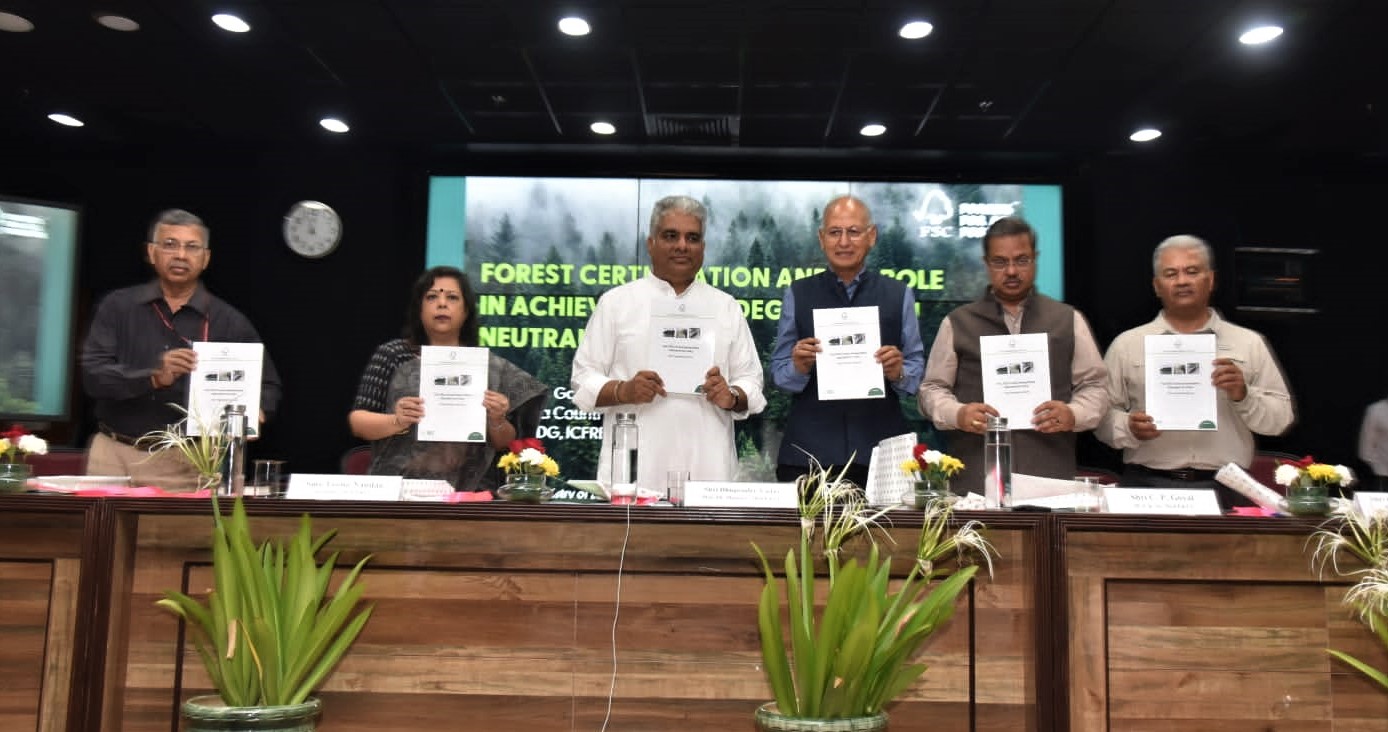This standard will cover all forest types, including natural forests and plantations, rough wood, and a variety of non-timber forest products. It will become effective on 1 September 2022.

From left to right: Mr Bivash Ranjan, Additional Director General, Ministry of Environment, Forest and Climate Change (MoEF&CC), Government of India; Ms Leena Nandan, Secretary, MoEF&CC; Mr Bhupender Yadav, Honourable Union Minister, MoEF&CC; Dr Suresh Gairola, FSC India Country Director; Mr C P Goyal, Director General of Forests and Special Secretary, MoEF&CC; and Mr S P Yadav, Additional Director General, MoEF&CC
India’s forests: A treasure trove of biodiversity, sustenance and economic support
India is the tenth-most forested country in the world, as well as one of the world’s 17 megadiverse countries. Home to nearly eight percent of globally-known flora and fauna, India’s forests cover 712,249 km2, or 21.67% of the country, and play an important role in global biodiversity conservation.
A unique facet of Indian forests is their crucial role in supporting the livelihoods of over 250 million people. The non-timber forest products (NTFP) sector is one of the largest unorganised sectors in rural India, supporting millions of people. In the three north-eastern states of Assam, Meghalaya and Mizoram, substantial forest areas are managed by autonomous district councils.
Trees Outside Forest (TOF), defined as “trees growing outsides recorded forests”, comprise 1,642 million m3 of the country’s total 5,915 m3 growing stock. TOF areas play a vital role in the social-economic life of rural India and generate valuable ecosystem services in urban and rural parts of the country. These areas are also highly significant to the India Forest Stewardship Standard, as timber and panel products of TOF origin have emerged as a major alternative to timber from forests, and have significantly decreased pressure on forests in recent years. They also play an important role in the livelihood of rural and urban Indians, from both an economic and ecological point of view.
India FSS: A multi-stakeholder consultation process
The Standard Development Group (SDG) responsible for developing the Forest Stewardship Standard (FSS) for India was established in December 2016. The SDG took part in a stakeholder identification process for each of FSC’s three chambers – environmental, social and economic. The first draft of the standard was prepared in August 2017, with the first public consultation held immediately afterwards, stretching over 75 days. Two day-long stakeholder workshops were conducted, one in the north and one in the south, in Delhi and Hyderabad, to ensure an inclusive approach to soliciting stakeholders’ comments.

The various stakeholder inputs were considered by the SDG when formulating the standard’s second draft, completed in February 2018. Field testing was carried out in Odisha and Assam states to practically test the second draft and gain forest managers’ feedback. The third draft was then written and opened for second public consultation in April 2019 which included an introduction to the environmental, social and economic criteria through a presentation given by experts.
After gathering further feedback and comments from stakeholders, the fourth draft was sent to FSC’s Performance and Standards Unit (PSU) in February 2020. At last, after multiple iterations, the final draft of the India FSS was approved by FSC’s Policy and Standards Committee December 2021 and released in April 2022. This standard becomes effective on 1 September 2022, with all existing certificate holders required to be audited in accordance with the standard within one year.

The India FSS: A cornerstone for forest sustainability
FSC believes the release of the India FSS is an important step towards achieving its 2050 vision of resilient forests sustaining life on Earth; and a significant contributor to FSC’s 2026 objective of growing its reach by demonstrating the value and benefits of forest stewardship. By 2026, FSC aims to have 300 million hectares of certified forests, of which 50 million hectares will be natural tropical forests and areas managed by smallholders.
Cindy Cheng, the FSC Asia-Pacific Regional Director, commented that “India’s forestry situation is totally unique, and the new standard reflects this, taking into account the needs and wishes of smallholders and managers of community forests across the country. The amount of work that went into developing this standard is truly impressive and I am so proud of everyone at FSC India for making it happen.”
Lieske van Santen, FSC’s Global Network Director, expressed the organisation’s pleasure at this achievement, saying “Congratulations to FSC India on this remarkable success. This is a culmination of the hard work of so many people, particularly those in the Standard Development Group and at FSC India. We are extremely pleased at the release of this global standard with local relevance, we are confident now we have this in place we can work towards connecting forest owners to 80 million of hectares potential FSC certified area in India.”
The FSC FSS for India (English version) can be viewed at the FSC Document Centre. The Hindi version will be published in due course of time.
Please contact Dr Suresh Gairola, FSC India Country Director, at s.gairola@fsc.org or Thesis Budiarto, Regional Policy Manager – Asia Pacific, at t.budiarto@fsc.org with any questions about this standard.
More about India’s biodiversity
- The seventh largest country in the world, India is bounded by the Great Himalaya mountain range in the north, stretching southwards and at the Tropic of Cancer, tapering off into the Indian Ocean between the Bay of Bengal on the east and the Arabian Sea on the west.
- India is divided into ten bio-geographic zones based on flora and fauna. About 5% of the geographical area is under protected area networks, comprising 106 national parks, 564 wildlife sanctuaries, 99 conservation reserves and 218 community reserves. There are 52 tiger reserves, 16 elephant reserves, 18 biosphere reserves, 49 Ramsar wetlands of international importance and 467 important bird areas in the country.
- The total tree cover is estimated as 95,027 km2, 2.89% of the country’s geographical area. The total forest and tree cover is 807,276 km2, 24.56% of the country’s geographical area.
- The total growing stock of wood is estimated to be 5,915 million m3, comprising of 4,273 million m3 inside forest areas and 1,642 million m3 outside recorded forest areas.
- Forests regulate hydrological cycles by increasing precipitation, recharging aquifers and maintaining the flow of water in rivers. India’s forests contain nearly 17,156 km2 of water bodies.
